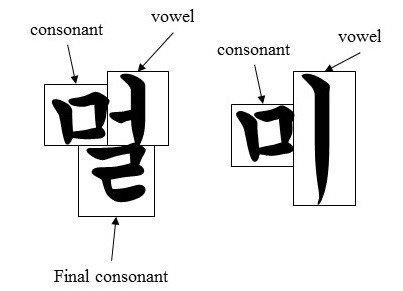The Korean alphabet, known as Hangul, is a unique and logical writing system created in the 15th century by King Sejong the Great and his scholars. Before Hangul, Koreans used Classical Chinese characters. The characters needed to be better suited to Korean.
Hangul was designed to be simple and accessible, promoting literacy among the people. The name "Hangul" combines the Korean words "han" (한), meaning "great" or "Korean," and "geul" (글), meaning "script," translating to "great script" or "Korean script."

What is the Korean Alphabet?
People respect Hangul for its scientific and logical design. Unlike many alphabets, Hangul's letters are made to show the sounds of spoken Korean. The consonant characters are based on the shape of the mouth and tongue when pronouncing them. At the same time, the vowels are constructed from three fundamental shapes representing the sky (a dot), the earth (a horizontal line), and a human (a vertical line).

Interesting Facts About the Korean Alphabet
- Invented for simplicity, Hangul was intentionally designed to be easy to learn. King Sejong wanted even the ordinary people who couldn't afford formal education to be able to read and write.
- Highly logical: The shapes of the consonants mimic the physical articulation of the sounds they represent. For instance, the consonant ㄴ (n) represents the tongue touching the roof of the mouth.
- Efficient Structure: Hangul is a compact and rhythmic writing system. Each syllabic block can contain up to four characters, making it highly space-efficient.
How Many Letters Are in the Korean Alphabet?
Hangul consists of 24 basic letters: 14 consonants and 10 vowels. Additionally, 16 compound letters are formed by combining these basic ones, bringing the total to 40 letters. The English alphabet has 26 letters. Hangul's structure is more modular. It allows using fewer symbols to make a vast array of sounds.
Comparing Hangul with the English Alphabet
English uses a linear arrangement of letters to form words. In contrast, Hangul's syllabic blocks create a more compact visual structure. Each block has at least one consonant and one vowel; some have extra consonants. This makes the script accessible to parse once you understand its basics.
Sound Representation
Hangul and English differ significantly in sound representation. Hangul includes sounds that are not present in English and vice versa. For example, Hangul has distinct letters for sounds that English represents with combinations of letters, such as "ch" (ㅊ), "sh" (ㅅ), and "ng" (ㅇ).
Conversely, English has sounds like "f" and "v" which Hangul approximates using ㅍ (p) and ㅂ (b).
Writing Words
In English, words are written in a linear sequence of individual letters, while in Hangul, words are constructed from syllabic blocks. Each block has at least one consonant and one vowel, arranged in a grid pattern. For example, the English word "love" is written as four separate letters, whereas the Korean word 사랑 (sarang) is written in two syllabic blocks, 사 (sa) and 랑 (rang). Syllables give a rhythm to the Korean alphabet by using consonants and vowels logically.
Learning the alphabet is a vital step in learning the language. Understanding the principles of Korean grammar can accelerate your learning about how to write and speak Korean.

The Structure of Hangul: Consonants and Vowels
Hangul's syllabic blocks are a distinctive feature that sets it apart from many other writing systems. These blocks are formed by combining consonants and vowels in a specific order.
Forming Syllabic Blocks
A typical syllabic block in Hangul can be structured in several ways:
Consonant + Vowel (CV): This is the simplest form, with a consonant followed by a vowel. For example:
- 가 (ga): The consonant ㄱ (g) combined with the vowel ㅏ (a).
Consonant + vowel + Consonant (CVC): In this form, a final consonant, known as a "batchim," is added to the CV structure. For example:
- 각 (gak): The consonant ㄱ (g), the vowel ㅏ (a), and the final consonant ㄱ (k).
Consonant + Vowel + Consonant + Consonant (CVCC): Some syllables have two final consonants. This structure is less common but still essential. For example:
- 없다 (eopda): The consonant ㅇ (silent), the vowel ㅓ (eo), and the final consonants ㅂ (b) and ㅅ (t).
Each block represents one syllable, and multiple blocks are combined to form words. For example, the word for "Korea" in Hangul is 한국 (hanguk), composed of two syllabic blocks: 한 (han) and 국 (guk).

Pronunciation Guide for Beginners
Learning to pronounce Hangul correctly is essential for mastering the Korean language. Each Hangul letter corresponds to a specific sound, which can be approximated using English phonetics.
People usually think learning Korean and Japanese is relatable because they belong to the same language family. But despite the debate, there are many similarities and differences between Korean and Japanese that can be considered for those interested in learning both languages.
Consonants
- ㄱ (g/k)
- ㄴ (n)
- ㄷ (d/t)
- ㄹ (r/l)
- ㅁ (m)
- ㅂ (b/p)
- ㅅ (s)
- ㅇ (silent/ng)
- ㅈ (j)
- ㅊ (ch)
- ㅋ (k)
- ㅌ (t)
- ㅍ (p)
- ㅎ (h)
Vowels
- ㅏ (a)
- ㅑ (ya)
- ㅓ (eo)
- ㅕ (yeo)
- ㅗ (o)
- ㅛ (yo)
- ㅜ (u)
- ㅠ (yu)
- ㅡ (eu)
- ㅣ (i)
Try to understand decent pronunciation before starting to go forward with the learning process.
Practical Tips for Learning Hangul
Mastering Hangul can be a rewarding experience. Our coherence guide for learning Korean has already helped many students to find this journey more fun. There are several strategies to make the process smoother.
Effective Learning Strategies
Use Flashcards and Mnemonics
Flashcards are an excellent way to memorize the characters, while mnemonics can help recall them. For instance, you might remember that ㅁ (m) looks like a mouth, which makes the "m" sound.
Practice Writing
Writing out the characters repeatedly will help you learn their shapes and stroke orders. Start with simple syllabic blocks and gradually move to more complex ones. Trying to write every word repeatedly will also help you understand how to read. Practice daily and dedicate time to mastering complex writing habits.
Engage with Native Content
Watch Korean dramas, listen to K-pop, and read simple Korean texts. This will help you see Hangul in action and improve your listening and comprehension skills.
Take Quizzes
Regularly testing your knowledge with quizzes can reinforce what you've learned and help you identify areas that need improvement.
Find a Study Group
Joining a study group can provide motivation and support. You can practice with others, share tips, and learn from each other's experiences.
Leveraging Online Resources
Online platforms like Superprof offer access to experienced Korean language tutors who can provide personalized lessons and guidance. Engaging with a Korean tutor can significantly enhance your learning experience by providing tailored instruction and feedback.

The Role of Hangul in Korean Culture
Hangul is more than just a writing system; it symbolizes Korean identity and pride. It has played a crucial role in unifying the Korean people and preserving their language and culture.
Cultural Significance
- National Pride: Hangul Day is on October 9th in South Korea. It commemorates the creation of Hangul and its importance in Korean history.
- Literary Contributions: Hangul has created much literature, ranging from classical poetry to modern novels. It has also made Korean culture more accessible to its people.
Educational Impact
- Hangul's simplicity has made literacy more accessible in Korea, resulting in one of the highest literacy rates in the world. The script's efficiency has also contributed to the rapid spread of information and ideas, fostering a vibrant cultural and intellectual environment.
Modern Usage
- In contemporary Korea, Hangul is used daily, from official documents and literature to digital communication and street signs. Its adaptability to modern technology has further cemented its role in Korean society.
Conclusion
The Korean alphabet, Hangul, is a remarkable and accessible writing system that can help one understand and appreciate the Korean language and culture.
Mastering Hangul allows you to read and write in Korean and connect more deeply with a rich cultural heritage. With all the tips and advice given to you, learning Korean should not seem as hard as before, and you can start your learning journey soon.
Utilize the tips and resources provided to enhance your learning journey, and consider engaging with a tutor for personalized instruction. Embrace the challenge and enjoy the rewarding experience of learning Hangul.















me ayudo demasiado a aprender, entendi la escritura y el Hangul.
Hola Isabella, nos alegramos de poder ayudarte! También puedes consultar nuestros profesores particulares aqui si quieres seguir aprendiendo :)
This article is very helpful 👍🏻